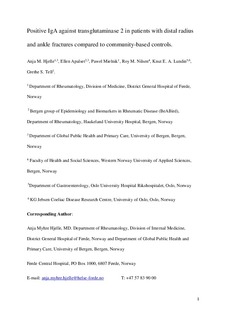| dc.contributor.author | Hjelle, Anja Myhre | |
| dc.contributor.author | Apalset, Ellen M | |
| dc.contributor.author | Pawel, Mielnik | |
| dc.contributor.author | Nilsen, Roy Miodini | |
| dc.contributor.author | Lundin, Knut Erik Aslaksen | |
| dc.contributor.author | Tell, Grethe S. | |
| dc.coverage.spatial | Norway, Sogn og Fjordane | nb_NO |
| dc.date.accessioned | 2019-03-21T10:03:28Z | |
| dc.date.available | 2019-03-21T10:03:28Z | |
| dc.date.created | 2018-10-04T15:22:40Z | |
| dc.date.issued | 2018 | |
| dc.identifier.citation | Hjelle, A. M., Apalset, E., Mielnik, P., Nilsen, R. M., Lundin, K. E. A., & Tell, G. S. (2018). Positive IgA against transglutaminase 2 in patients with distal radius and ankle fractures compared to community-based controls. Scandinavian Journal of Gastroenterology, 53, 1212-1216. | nb_NO |
| dc.identifier.issn | 0036-5521 | |
| dc.identifier.uri | http://hdl.handle.net/11250/2591024 | |
| dc.description | This is the author's manuscript (preprint) of an article published by Taylor & Francis in Scandinavian Journal of Gastroenterology on 28 Sep 2018, available online: https://www.tandfonline.com/doi/full/10.1080/00365521.2018.1509122 | nb_NO |
| dc.description.abstract | Backgroud: Patients with celiac disease (CD), including adults with subclinical disease, have low bone mineral density (BMD), deteriorated bone microarchitecture; metanalysis show an increased risk of fracture. Immunoglobulin A (IgA) against transglutaminase 2 (IgA TG2) is a highly reliable marker to detect CD.
Main objective: To explore the prevalence of positive IgA TG2 and CD in patients with distal radius and ankle fracture compared to community-based controls.
Methods: 400 patients age 40 years or above with distal fractures were included in a case-control study. 197 controls were identified from the National Population Registry, those included had never suffered a fracture. BMD was measured, and comorbidities, medications, physical activity, smoking habits, body mass index (BMI) and nutritional factors were registered. Blood analysis to detect common causes of secondary osteoporosis was performed.
Results: 2.5% of the fracture patients had positive IgA TG2, compared to 1% in the control group. The odds ratio, adjusted for sex and age, of having positive IgA TG2 was 2.50 (95% CI 0.54 – 11.56).
Conclusions: There were no significantly increased odds of CD in adult patients with fractures compared to controls, however results imply that positive IgA TG2 is more prevalent in fracture patients than in controls. This study indicates that universal screening for CD in fracture patients is not warranted, but supports current clinical practice in Norway to suspect and investigate for CD in patients with fracture, osteoporosis and other risk factors for CD. | nb_NO |
| dc.language.iso | eng | nb_NO |
| dc.publisher | Taylor & Francis | nb_NO |
| dc.subject | IgA against transglutaminase 2 | nb_NO |
| dc.subject | bone mineral density | nb_NO |
| dc.subject | osteoporosis | nb_NO |
| dc.subject | fracture | nb_NO |
| dc.subject | celiac disease | nb_NO |
| dc.title | Positive IgA against transglutaminase 2 in patients with distal radius and ankle fractures compared to community-based controls | nb_NO |
| dc.type | Journal article | nb_NO |
| dc.type | Peer reviewed | nb_NO |
| dc.description.version | submittedVersion | nb_NO |
| dc.subject.nsi | VDP::Medisinske Fag: 700::Klinisk medisinske fag: 750::Reumatologi: 759 | nb_NO |
| dc.source.pagenumber | 1-6 | nb_NO |
| dc.source.volume | 53 | nb_NO |
| dc.source.journal | Scandinavian Journal of Gastroenterology | nb_NO |
| dc.source.issue | 10-11 | nb_NO |
| dc.identifier.doi | 10.1080/00365521.2018.1509122 | |
| dc.identifier.cristin | 1618035 | |
| dc.relation.project | Stiftelsen Kristian Gerhard Jebsen: SKGJ-MED-017 | nb_NO |
| cristin.unitcode | 203,11,2,0 | |
| cristin.unitname | Institutt for helse og funksjon | |
| cristin.ispublished | true | |
| cristin.fulltext | original | |
| cristin.fulltext | preprint | |
| cristin.qualitycode | 1 | |
